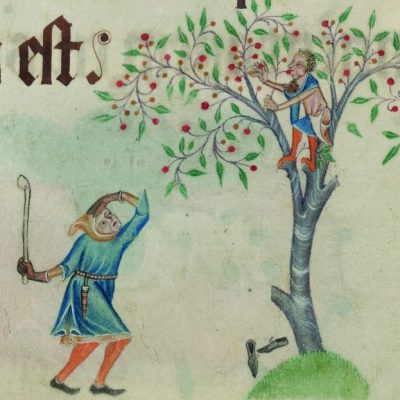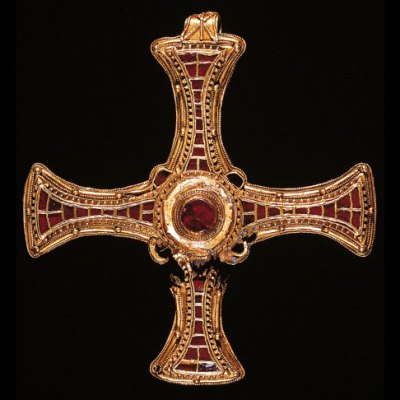[Life] is like the swift flight of a single sparrow through the banqueting hall […]. In the midst there is a comforting fire to warm the hall; outside, the storms of winter rain or snow are raging – Ecclesiastical History of the English People, Bede
‘Anglo-Saxon Kingdoms: Art, Word, War’ reveals the vibrant culture of early England: born of migrants and decidedly ‘European’, with connections reaching up to and beyond the Christian and Islamic territories that cradled the Mediterranean. Couched within these compelling political narratives are artworks of great beauty, technical virtuosity and intellectual subtlety.
According to Bede’s History from 731, the English were a meld of Germanic tribes that colonised lands from Kent to Northumbria; he does not use the term ‘Anglo-Saxons’, as this was only applied after the Norman Conquest to distinguish the population of England before 1066. In modern scholarship, the Anglo-Saxon period begins from around the early fifth century (with the withdrawal of Roman legions from Britain) and ends incrementally in the 11th with Danish rule and the arrival of the Normans.
English identity coalesces throughout the galleries. Manuscripts are poised like birds mid-flight, open as far as their bindings will allow, and interspersed with objects of stone, bone, metal, enamel and ceramics. Most of the 180 artefacts – not all elite – bear words in Roman, runic or Ogham scripts. Throughout, a host of styles – geometric, painterly, naturalistic – speak of diverse influences and agendas. Banners depicting natural and architectural scenes intimate the artefacts’ original settings, but otherwise the atmosphere is dark, kind to fragile pigments, and conducive to the spotlighting of blockbuster exhibits.
Belt buckle (early 7th century), excavated at Sutton Hoo ship burial site, Suffolk. Photo: © The Trustees of the British Museum, London

Gold, cast as though chip-carved, and garnet cloisonné dominate a wall display at the base of the stairs from the first room. It contains pieces from the Staffordshire Hoard (discovered in 2009), accompanied by sword fittings and the dazzling belt-buckle excavated 70 years earlier from the Sutton Hoo ship burial. The latter treasures are arranged to simulate their intended position when worn and their lighting and proximity to the glass allows for such close looking that the delicate waffle-textured gold beneath the garnets is clearly visible. Subsequent displays call for examination of comparably delicate craftsmanship, though the proliferation of artefacts requires a degree of endurance.
Meditating upon the knotted art of the Insular gospel books – Durrow and Lindisfarne among them – is to invoke their original function. Some feature carpet pages, which precede the opening pages of gospel texts, invite contemplation of sacred cruciform geometry and probably served a similar meditative purpose to Islamic prayer mats. Enlarged and ornamented initials begin the gospel on the facing page, vibrating with complementary colours, impossibly fine interlace, intricate fretwork and tense spirals, before shrinking to the dark text of the Scripture. Their illumination renders in paint the interlace of the Staffordshire and Sutton Hoo treasures and the wheeling trumpet-scrolls of the Hockwold enamelled mounts in the earlier wall display. Here, direct visual comparisons with metalwork would have helped convey the complex influences on the books’ ornamental language.
The Book of Durrow (ff. 85v–86r) (c. 700), probably Durrow, Co. Offaly, or Iona, vellum, 24.5 × 14.5cm. Trinity College Dublin

Material flexibility, the mesmeric surfaces of the cross and a powerful sense of vernacular tradition also resonate in the juxtaposition of the Vercelli Book and the Ruthwell Cross. Both contain versions of the Old English poem The Dream of the Rood, though only in full in the former, which is a product of southern England from the second half of the 10th century. A dreaming narrator sees a tree of gold: wound around with light and adorned with gems. Yet, through the gold, blood seems to stream from old injuries. The tree is Christ’s cross, at once a metalwork crux gemmata and a wooden instrument of torture. Then it begins to speak, telling the story of the Crucifixion in its own words.
Lines from the same poem are inscribed vertically in runes on the surface of the 8th-century Ruthwell Cross in Dumfriesshire. If the runes are contemporary with the rest of the cross, then they are some 150–200 years older than the manuscript text, while the language used is earlier still. As it could not be brought to London, a full-scale replica has been erected in front of the Vercelli Book.
It tempers the exhibition’s inevitable emphasis on manuscripts. Their juxtaposition drives home the loss of intermediary versions of the poem, transmitted both orally and in writing. The weight of other losses is palpable throughout ‘Anglo-Saxon Kingdoms’, whether in the burnt margins of the Beowulf manuscript or the Exeter book riddle of the book-moth: ‘the worm, a thief in the night, / had swallowed the speech / of a man.’
Pendant (first half 7th century), probably East Anglia or Kent, excavated at Winfarthing, Norfolk. Norwich Castle Museum

Such is the age of the artefacts displayed and such is the precariousness of their survival that it is often impossible to trace direct relationships. For this reason, art historians of the Middle Ages will flock to three similarly sized psalters (books of psalms) displayed open on the same psalm near the end of the show: the Utrecht, Harley and Eadwine Psalters. The earliest is a book of c. 825 that came to Canterbury from Reims by the first half of the 11th century, before finding its way to Utrecht in the 18th century. It is illustrated with 166 pen drawings in a feral, impressionistic style. Scribes and artists at Canterbury made at least three copies. The Harley Psalter (c. 1000–50) modifies its model by using coloured inks. Then the Eadwine Psalter (c. 1150) builds a textual commentary around the psalms and introduces borders and coloured wash. Sadly, the latest in the series, the Great Canterbury Psalter of the late 12th century, is not in the exhibition. Its miniatures are densely coloured and framed, but follow its predecessors’ iconographic scheme. Be that as it may the present trio is enough to suggest the process of gradual innovation over two centuries.
‘Anglo-Saxon Kingdoms: Art, Word, War’ is a sparrow-through-the-hall adventure that offers more than respite from London’s ‘storms of winter rain’. Culminating in the Domesday Book, the exhibition reveals writing as a crucial administrative tool in England’s formation as a political entity. Conversely, its displays of art and poetry describe a culture not in thrall to the written word, but exploring its potentials and limits as a vessel for ornament, as code for speech, as fodder for ravenous worms.
‘Anglo-Saxon Kingdoms: Art, World, War’ is at the British Library, London until 19 February 2019.
From the December 2018 issue of Apollo. Preview and subscribe here.



